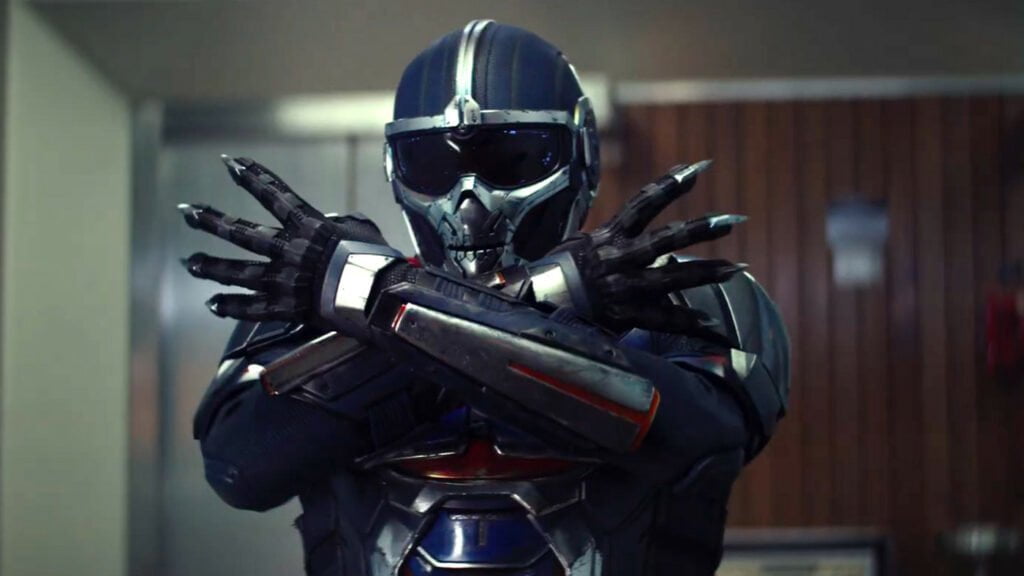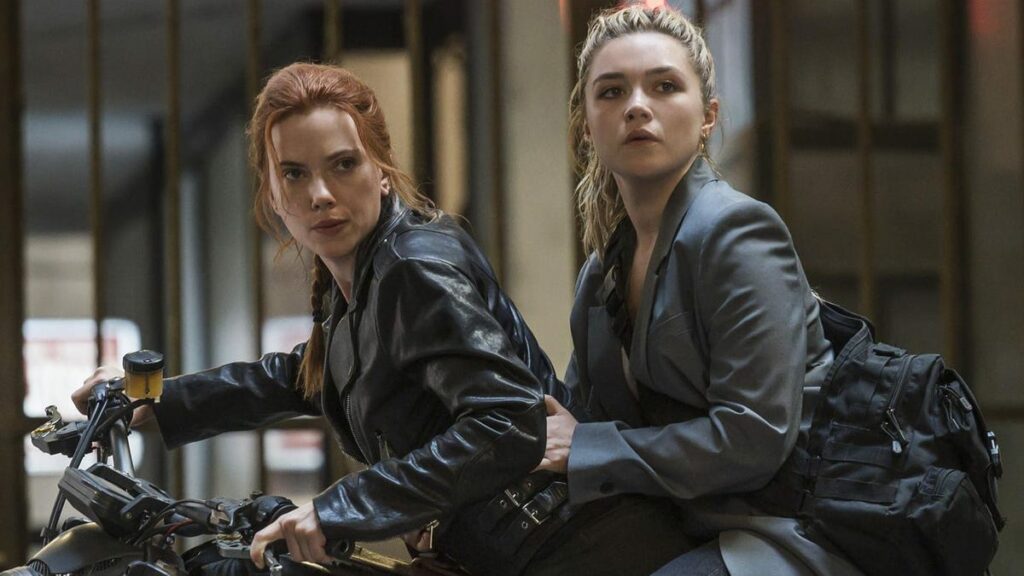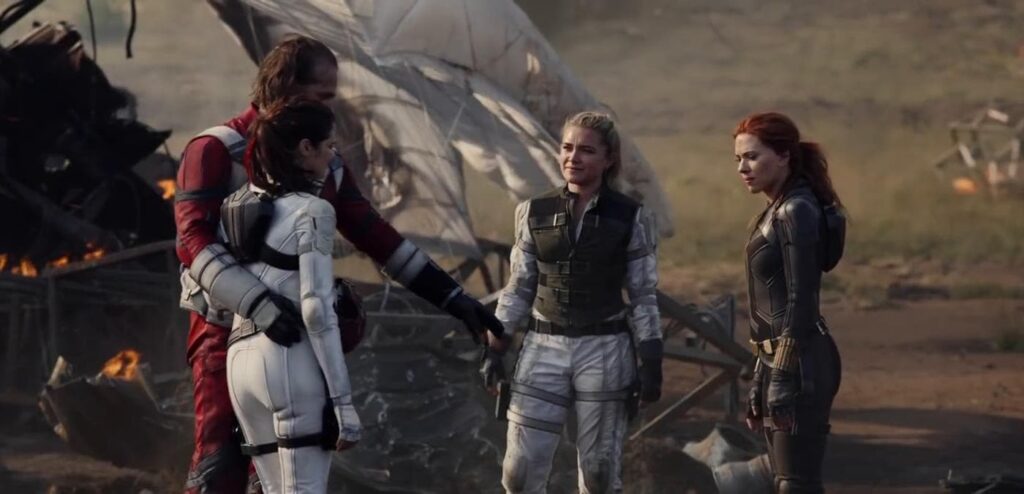Twenty-one years before, Alexei Shostakov and Melina Vostokoff were undercover agents who escaped to Cuba after retrieving S.H.I.E.L.D. intel for General Dreykov. In Ohio, Shostakov and Vostokoff posed as a family with two daughters, namely Natasha Romanoff and Yelena Belova. Immediately on their arrival in Cuba, Romanoff and Belova were taken to the Red Room for training.
In Black Widow, an accelerated montage informs us that Romanoff and Belova were placed, or rather caged, in Dreykov’s Red Room to undergo severe training to become Black Widows. Inside the Red Room, only one in twenty women could survive. In addition, their uterus and ovaries were removed on account of ‘involuntary hysterectomy’. Why? Possibly because of Dreykov’s perception of women’s reproductive organs as weak and vulnerable obstacles in his pursuit of transnational domination.
Dreykov’s history of inflicting patriarchal violence on women extends beyond the scarred bodies of Red Room ‘fellows’. For instance, when Romanoff’s earlier attack directed against him fatally injured his young daughter Antonia, he put a chip in the back of her neck and eventually began controlling her mind. Antonia became his ‘Taskmaster’ since her newfound photographic reflexes could identify and mimic the antagonist’s strategies. When Antonio gets physically and mentally freed from her father’s control in the film’s end, her first question is: “Is he gone?“

Additionally, in his confrontation with Romanoff, Dreykov proudly insists that he “recycles” orphaned “trash”, namely young girls, to make them reliable instruments trained to follow his command. The subculture of trafficking and exploiting young girls becomes the foundation on which he builds his empire. Even as Dreykov depends on the labour of ‘his’ Widows, he refuses to acknowledge and respect their humanity as both humans and workers. Consequently, his role as a patriarch is supplemented by his bourgeois control.
Also read: Ant-Man And The Wasp Is Marvel’s First Female-Led Superhero Movie!
In our appreciation of the feminist aspects of this film, we cannot ignore the broader framework of American imperialism in which the savage ‘Other’ is a Russian man. Transnational creation of Russia as the enemy-state is common. The Bond novels and films of the Cold War frequently pitted the ‘righteous’ Bond against a Russian ‘intruder’. In recent years, many films of the Mission Impossible series have utilised a similar trope.
For instance, in a Bond film, James Bond will never be morally wrong. Similarly, in a Mission Impossible film, the impeccable Ethan Hunt will always remain an upright American man whose ultimate goal is world peace. Given the social capital that Disney has, an overemphasis on American ‘values’ in Black Widow and other Marvel films can perpetuate popular stereotypes in unimaginably disastrous ways. Kirsten Holst Petersen rightly asks, “Which is the more important, which comes first, the fight for female equality or the fight against Western cultural imperialism?” Our goal is not to locate a simplistic answer to Petersen’s question. Rather, as intersectional feminists, it is our responsibility to acknowledge the racist impulses of the film even as we appreciate the feminist dialogue that it sustains.

Similarly, the anthropocentric viewpoint that the film largely upholds needs to be examined from an intersectional lens. Dreykov uses a mind-control agent on not only his daughter, but also the Widows. The chemical effectively renders the Widows incapable of free will, implying that they can involuntarily succumb to his will.
The Russian discovery and development of this mind-control agent can be traced back to Shostakov and Vostokoff’s mission as undercover agents. In Black Widow, when the ‘family’ comes together to defeat Dreykov, Vostokoff explains that her mind-control experiments on pigs characterise the enhancement of the chemical used on Widows. The exploitative use of pigs as test ‘subjects’ is depicted in a normalised and matter-of-fact tone. Romanoff’s temporary objection fails to verbalise any cogent resistance.

Given the film’s emphasis on patriarchal violence against women, the question of solidarity also gains importance. Dreykov’s patriarchal domination endeavours to obliterate the very possibility of feminist solidarities, yet his hope is short-lived. The truce between Romanoff and Belova inaugurates feminist action in the film, which then shapes other female homosocial relationships. Another aspect that facilitates bonding among women is the antidote that neutralises the chemical agent. Toward the end, the film culminates its feminist ecosystem by freeing Antonia from the manipulation of her father’s cage and chemical.
Black Widow is a promising film that offers its viewers an engaging experience. However, its problematic elements need to be assessed, particularly because of the power that Disney wields on the popular culture. Perhaps the most pathetic aspect of Disney’s power is its ability to accept feminism as a ‘performance’, but to dismiss its qualitative arguments in practice. This is why I would urge you to seriously consider Scarlett Johansson’s legal action against Disney and watch the film on a third party website in order to deny, at least in some capacity, the same money that Disney has denied to Johansson.
Also read: WandaVision: The Power Of Grief And Love
All images are stills from the film Black Widow
About the author(s)
Mridula Sharma is a researcher and a writer. Her work lies in the intersection of feminist theory, postcolonial studies, and popular culture.





